As the AI renaissance sweeps through industries, a new style of leadership is emerging—one that keeps humans at the heart of technological advancement. This shift towards human-centered leadership in AI is not just a trend but a transformative approach that could redefine how technology and human values coexist. The ability to balance AI integration with human values will separate visionary leaders from those bound to fall behind.
The announcement comes as generative AI continues to reshape the global landscape. With a staggering $4.4 trillion contribution to the global economy and the rapid adoption exemplified by ChatGPT’s record-breaking 100 million users, the transformative power of AI is clear. According to Digital Journal, industries are reimagining competitive strategies, emphasizing agility and human value.
The AI Renaissance: A New Era of Potential
Generative AI might not think like humans, but its impact is undeniable. The AI renaissance represents a pivotal moment in technological history, where the potential for innovation is matched by the need for ethical leadership. As companies across sectors embrace AI, the focus is shifting towards integrating these technologies in ways that enhance, rather than replace, human capabilities.
In an age where knowledge is democratized, the key lies not in hoarding information but in how rapidly organizations can synthesize and act on it. Companies that embrace this shift are not just deploying AI to automate processes but are enhancing human creativity and decision-making.
Innovating with a Human Touch
Examples of human-centered AI are emerging across various industries, illustrating how technology can augment rather than replace human roles. This development follows a broader trend of integrating AI in ways that prioritize human input and creativity.
Examples of Human-Centered AI
- Augmented Decision-Making: Rather than automating decisions, AI provides analyses, allowing humans to maintain control.
- Enhanced Creativity: AI tools assist designers and strategists, while human insight determines the best ideas.
- Personalized Learning: Dynamic AI systems tailor to individual needs, enabling educators to focus on mentorship.
Leading through Transition
The World Economic Forum predicts that while AI may displace 92 million jobs, it could also create 170 million new ones. This transition demands forward-thinking leadership that understands restructuring around AI-human collaboration is essential—not optional. The move represents a significant shift in how businesses operate, requiring leaders to be adaptable and innovative.
Meanwhile, the landscape of business is chaotic, with geopolitical tensions and regulatory challenges further complicating the scene. As this era of destabilization unfolds, leaders must navigate with insight, preparing to write the AI era’s next chapters while ensuring that human values remain at its core.
The Imperative of Human Value
Tech trends come and go, yet the necessity of preserving human dignity in business remains. Leaders investing equally in AI and human skills, like creativity and empathy, will define the future. The renaissance of AI requires not just technical adaptation but ethical leadership focused on human innovation.
The conversation about the fusion of AI and leadership is not just about technology—it’s about shaping a future where human ingenuity and technological advancement go hand in hand. The implications of this shift are profound, suggesting a future where human-centered leadership could become the norm, not the exception.
As industries continue to evolve, the next steps involve not only embracing AI but doing so in a way that enhances human potential. The path forward is clear: leaders must prioritize human values to harness the full potential of AI, ensuring a future where technology serves humanity, not the other way around.
 Judge Overturns Trump-Era Health Data Policy, Restores Transparency
Judge Overturns Trump-Era Health Data Policy, Restores Transparency Fortune Brainstorm Tech 2025: Innovators Converge in Utah for Pioneering Summit
Fortune Brainstorm Tech 2025: Innovators Converge in Utah for Pioneering Summit Amazon Slashes Fire TV Stick 4K Max Price for Prime Day Bonanza
Amazon Slashes Fire TV Stick 4K Max Price for Prime Day Bonanza Nvidia Offers Free Adobe Creative Cloud Access with Key Conditions
Nvidia Offers Free Adobe Creative Cloud Access with Key Conditions RFK Jr. Halts U.S. Funding for Gavi, Impacting Global Vaccination Efforts
RFK Jr. Halts U.S. Funding for Gavi, Impacting Global Vaccination Efforts